Alycia Halladay, PhD, Chief Science Officer
2014 was a big year for autism research, and there have been a number of perspectives on the science of autism in 2014. In fact, the Simons Foundation did a beautiful job outlining some of the major scientific advances, hot topics, notable findings and new tools that were discovered or developed in 2014. Please take a look at their year end summary on their website, sfari.org. ASF would like to provide additional perspective on what has been accomplished in research and where science is leading.
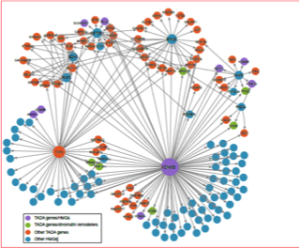
Synaptic, Transcriptional, and Chromatin Genes Disrupted in Autism
First, genetic findings made a major impact this year. Resources like the Autism Sequencing Consortium, the Autism Genetic Resource Exchange, the Simon Simplex Collection, and the Autism Genome Program were harnessed together to identify different types of mutations, and more importantly, map them out to see how they all fit together. After decades of identifying small or large mutations in single genes, the scientific field was ready to understand the relationship these genes had to each other, and to common pathways of function. The best examples of this were two papers published in Nature and Nature Neuroscience that were published in the last half of the year [1, 2]. They laid out the relationships between the different categories of genes associated with autism. One new category of genes was added that was not discovered until this year – it related to chromatin remodeling genes [3]. These are genes that don’t control protein synthesis, but actually decide how the DNA is shaped. Because you have enough DNA to reach the moon if it were unfolded and straightened out, the DNA needs to be stuffed into cells and shaped properly. An analogy to this is folded laundry. If the laundry isn’t folded properly, clothes wrinkle. Like laundry, if DNA isn’t folded properly, it doesn’t express proteins in the right way. Changes in gene expression without an actual change in the DNA sequence is called “epigenetics”, and this is an area of research that needs more study in autism. Given the findings this year and the role of environment in epigenetics (more on this later) it is likely to be something research will focus in on in 2015.
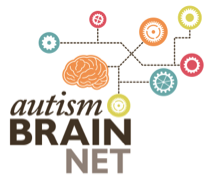
Another important approach that was advanced this year was the use of sequencing in understanding genetics. Instead of looking at individual mutations of amino acids, the entire exome, or the code that directs protein synthesis, was sequenced [4]. Through this method, more genes related to autism were discovered and the way these mutations were passed on was identified. One of the major contributions from sequencing efforts was the confirmation that genes that are highly expressed in the brain are differentially affected in people with ASD [2]. There was a lot of work that went into this discovery. For example, how do we know what is a gene that is highly expressed in the brain and how do we know what happens in the brains of people with autism? For this, we need brain tissue. In 2014, The Simons Foundation for Autism Research (SFARI), Autism Speaks and ASF launched a new awareness and outreach campaign for a new and improved brain tissue collection program called Autism BrainNet. Instead of one collection site, there will be four, so hopefully, there will be four times the number of brains collected. Through brain tissue, we saw a number of important findings that may lead to treatments. It took decades to accumulate a dataset large enough to show that a type of immune cell in the brain, microglia, is turned on in relation to how brain cells that control neural function, are activated. There has been much research over the years on the role of microglia and the immune system in autism, and this relationship suggests that while activated microglia may not be the singular cause of ASD, it may reflect ongoing abnormal processes in brain function. The role of the immune system in ASD is another hot topic for research. In another breakthrough study, a group at Columbia showed that people with autism have an overabundance of dendritic spines. Dendritic spines are points on the neuron that make contact with other neurons [5]. They took their study a step further by then studying dendritic spines in an animal model of Tuberous Sclerosis, a disease with behavioral similarities to ASD. What was remarkable is that treating these animals with a drug called rapamycin reduced this overabundance of spines. If this line of research continues to move forward, there may be a new viable medication for autism symptoms that is linked to brain pathology. What we need is more research, and more brain tissue.

Air traffic pollution mixes with genetic background to increase risk of ASD
This year, an important study was published confirming the interplay between an environmental exposure and an autism gene. (6) While studying genes and environmental exposures independently is important, scientists have agreed that it is the interaction of the two that may be important in ASD. In 2014, two published studies from the United States showed an association between high levels of air pollution exposure and increased autism risk [6, 7]. In a third, Heather Volk at USC showed that air pollution increases risk, but this risk was further elevated when a mutation in an autism gene is present. So, does air pollution cause autism? Maybe not, but clearly it’s a risk factor that doesn’t help brain development. As high levels of air pollution are associated with so many adverse health outcomes in children and adults, it’s hard not to argue it should be a target of prevention in ASD. And it’s something that is actionable – regulations in toxic release have improved air quality in the last two decades. Also, studies in China have reported changes in health biomarkers and neurodevelopmental markers with improvements in air quality [8]. But most importantly, this finding reveals that more studies need to be done looking at not just genetics, but gene/environment interactions. The role of the environment is especially interesting since environmental factors are known to act epigenetically, that is, they modify gene expression without changing DNA sequence. So now that a gene that modifies DNA expression without changing DNA sequence has been identified, there is a viable target to study.
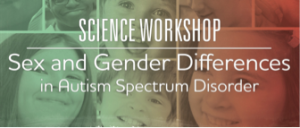
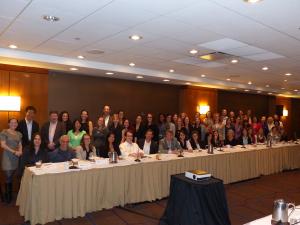
Participants at the sex and gender differences meeting in October
Who could leave 2014 without talking about the new, and much deserved attention to, the male sex bias in autism? In October, ASF and Autism Speaks co-organized a meeting to try to better understand the 4-1 male/female autism diagnosis ratio. A link to the podcast and the agenda can be found on the ASF website. A number of publications came out this year showing that females actually had a higher burden of genetic mutations compared to males, indicating something was “protecting” females from some autism symptoms [1, 9, 10]. If we could figure out what is protecting females, if they are protected in some way, could we bottle that for translational impact? On the other hand, are some females with autism just suffering in silence during childhood, only to be mis-diagnosed or underdiagnosed? This is an area that so deserves further study. Not just for the translational potential, but for better services for females with ASD.
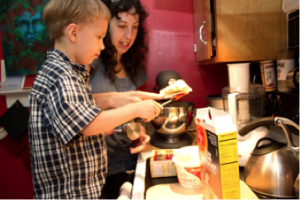
Early Social Interaction project being delivered at home by parents
Finally, some of the most impactful papers came from those studying the early detection and intervention of ASD and intervention across the lifespan. For example, for the first time, comprehensive behavioral interventions targeted at cognition and communication were delivered to infants as young as 6 months, with promising results [11] . Also, a low cost, easy to implement intervention for early motor behaviors showed promise in infants [12]. It’s still not clear if these interventions “prevent” autism emergence or diagnosis, but they do improve certain domains related to autism. Another long-awaited early intervention study in toddlers with ASD was published and showed efficacy of an intervention called “Early Social Interaction” which showed significant effects on adaptive behavior and autism symptoms compared to those who did not receive the same intervention. What was remarkable was that in this study, parents implemented the interventions at home, after being trained. [13]. But we know that not all people with ASD follow the same pathway of the same early symptoms with the same outcomes. This was demonstrated in the largest study of high-risk infants tracking behaviors from 1 ½ years to age of diagnosis[14]. Understanding how autism symptoms emerge will lead to specific interventions at early ages to improve skills for all people affected with ASD.
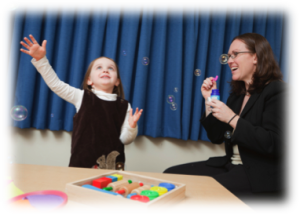
Pam Ventola from Yale enjoys delivering PRT to a child in her study
But the research didn’t just focus on infants and toddlers. The science around a behavioral intervention called PRT or pivotal response training in children and adolescents showed important advances. First, children of parents who were trained in PRT techniques showed improved outcome [15]. PRT was able to reverse the differences in brain activity seen in individuals with ASD. It also resulted in improvements in language and adaptive behavior [16]. Because of long waits for clinic-based approaches, interventions that are delivered by parents, caregivers and teachers need further data behind them, and need evidence-based adaptation for delivery. There are so many challenges behind getting caregivers and teachers to implement interventions at home or in the classroom setting, and figuring out ways in which this can be done better should be a priority for public health research in ASD.
The lives of people with ASD are made better through research. Before they can be declared “effective”, interventions have to be studied in real-life settings. Scientific findings must be discovered and then replicated to ensure that researchers are on the right path. This year’s collection of discoveries would not have been possible without researchers, scientists and research staff who dedicate their lives to helping people with autism; the families participating in research; all the people registering for post-mortem brain tissue donation; and individuals supporting science through their generous donation of funds. Thank you and have a great 2015.
- Chang J, Gilman SR, Chiang AH, Sanders SJ, Vitkup D: Genotype to phenotype relationships in autism spectrum disorders. Nature neuroscience 2014.
- De Rubeis S, He X, Goldberg AP, Poultney CS, Samocha K, Ercument Cicek A, Kou Y, Liu L, Fromer M, Walker S, et al: Synaptic, transcriptional and chromatin genes disrupted in autism. Nature 2014, 515:209-215.
- Bernier R, Golzio C, Xiong B, Stessman HA, Coe BP, Penn O, Witherspoon K, Gerdts J, Baker C, Vulto-van Silfhout AT, et al: Disruptive CHD8 mutations define a subtype of autism early in development. Cell 2014, 158:263-276.
- Uddin M, Tammimies K, Pellecchia G, Alipanahi B, Hu P, Wang Z, Pinto D, Lau L, Nalpathamkalam T, Marshall CR, et al: Brain-expressed exons under purifying selection are enriched for de novo mutations in autism spectrum disorder. Nature genetics 2014, 46:742-747.
- Tang G, Gudsnuk K, Kuo SH, Cotrina ML, Rosoklija G, Sosunov A, Sonders MS, Kanter E, Castagna C, Yamamoto A, et al: Loss of mTOR-dependent macroautophagy causes autistic-like synaptic pruning deficits. Neuron 2014, 83:1131-1143.
- Raz R, Roberts AL, Lyall K, Hart JE, Just AC, Laden F, Weisskopf MG: Autism Spectrum Disorder and Particulate Matter Air Pollution before, during, and after Pregnancy: A Nested Case-Control Analysis within the Nurses’ Health Study II Cohort. Environmental health perspectives 2014.
- Kalkbrenner AE, Windham GC, Serre ML, Akita Y, Wang X, Hoffman K, Thayer BP, Daniels JL: Particulate matter exposure, prenatal and postnatal windows of susceptibility, and autism spectrum disorders. Epidemiology 2015, 26:30-42.
- Tang D, Lee J, Muirhead L, Li TY, Qu L, Yu J, Perera F: Molecular and neurodevelopmental benefits to children of closure of a coal burning power plant in China. PloS one 2014, 9:e91966.
- Iossifov I, O’Roak BJ, Sanders SJ, Ronemus M, Krumm N, Levy D, Stessman HA, Witherspoon KT, Vives L, Patterson KE, et al: The contribution of de novo coding mutations to autism spectrum disorder. Nature 2014, 515:216-221.
- Jacquemont S, Coe BP, Hersch M, Duyzend MH, Krumm N, Bergmann S, Beckmann JS, Rosenfeld JA, Eichler EE: A higher mutational burden in females supports a “female protective model” in neurodevelopmental disorders. American journal of human genetics 2014, 94:415-425.
- Rogers SJ, Vismara L, Wagner AL, McCormick C, Young G, Ozonoff S: Autism treatment in the first year of life: a pilot study of infant start, a parent-implemented intervention for symptomatic infants. Journal of autism and developmental disorders 2014, 44:2981-2995.
- Libertus K, Landa RJ: Scaffolded reaching experiences encourage grasping activity in infants at high risk for autism. Frontiers in psychology 2014, 5:1071.
- Wetherby AM, Guthrie W, Woods J, Schatschneider C, Holland RD, Morgan L, Lord C: Parent-Implemented Social Intervention for Toddlers With Autism: An RCT. Pediatrics 2014, 134:1084-1093.
- Chawarska K, Shic F, Macari S, Campbell DJ, Brian J, Landa R, Hutman T, Nelson CA, Ozonoff S, Tager-Flusberg H, et al: 18-month predictors of later outcomes in younger siblings of children with autism spectrum disorder: a baby siblings research consortium study. Journal of the American Academy of Child and Adolescent Psychiatry 2014, 53:1317-1327 e1311.
- Hardan AY, Gengoux GW, Berquist KL, Libove RA, Ardel CM, Phillips J, Frazier TW, Minjarez MB: A randomized controlled trial of Pivotal Response Treatment Group for parents of children with autism. Journal of child psychology and psychiatry, and allied disciplines 2014.
- Ventola P, Yang DY, Friedman HE, Oosting D, Wolf J, Sukhodolsky DG, Pelphrey KA: Heterogeneity of neural mechanisms of response to pivotal response treatment. Brain imaging and behavior 2014.
